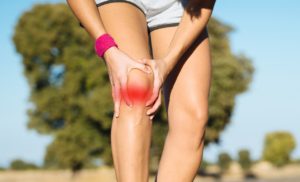Meniscal Tear

What is a meniscus?
The meniscus is a disk of cartilage in the middle of the knee. The meniscus is separate from the cartilage that covers the end of the bones in the knee joint. There are two menisci in each knee, one on each side of the joint (medial and lateral). Their purpose is to cushion the joint during weight-bearing activities.
What is a meniscus to tear and what causes it?
A meniscal tear is just what it sounds like – a partial or complete tear in the meniscus. These tears come in several shapes, sizes, and locations on the meniscus. They can occur when the knee is forcefully twisted or on occasion with extreme bending of the knee such as with squatting. Although running does not typically involve twisting and extreme knee bending, cross-training in the gym does. In addition, uneven terrain encountered on trail runs or obstacle races can involve the twisting and bending forces that create a meniscal tear.
What are the symptoms of a meniscal tear?
Swelling and pain in the knee joint are often the primary symptoms of a meniscal tear. The knee may “lock up” or you may feel a “click” a “pop” or a “snap” in the joint with knee movement.
How is a meniscal tear diagnosed?
Clinical examination is necessary to make the diagnosis of a meniscal tear. Typically a doctor or therapist will find pain along the joint line and with movement and rotation of the knee joint. Often an MRI is needed to diagnose the tear and grade the severity of the tear.
How is a meniscal tear treated?
Treatment for meniscal tear focuses on two main problems: inflammation and biomechanics. Inflammation is best treated with ice, non-steroidal anti-inflammatory drugs (NSAIDs) and rest. A cortisone injection can reduce pain and inflammation inside the joint, but does not “fix” the torn meniscus. Knee bracing to immobilize the knee can reduce movements that would cause further damage the meniscus. Physical therapy can improve strength and flexibility in the leg around the joint and this may reduce forces in the knee causing pain. If the pain does not subside with conservative treatment, surgery becomes necessary to repair the meniscal tear. The surgery is performed arthroscopically. When surgery is being considered, consultation with an orthopedic surgeon is necessary.
When can I return to running?
The goal of rehabilitation is return you to running as soon as is safely possible. If you return to a full training load too soon, the injury may return or worsen. Everyone recovers from injury at a different rate, so don’t compare your rehabilitation to other runners. Returning to running is determined by how well your knee responds to treatment rather than a set number of days or weeks. In general, the longer you have had the symptoms, the longer it will take you to recover. Here are some general guidelines for a full return to running. Keep in mind, some runners may not have to completely stop running, but merely reduce their training load (distance, intensity, frequency) during the rehabilitation process.
- You should be able to bend and straighten your knee without pain.
- Your knee should not be swollen.
- You should be able to jog in a straight line without limping.
- You should be able to sprint without limping.
- You should be able to perform 45-degree and 90-degree cuts without difficulty.
- You should be able to jump on both legs without pain.
- You should able to jump on the injured leg without pain.
What can be done to reduce the chances of developing a meniscal tear?
Most meniscal tears are the result of an acute injury. Therefore, they are not preventable in the same way other running injuries are preventable. Optimizing the biomechanics in the leg can reduce forces in the knee and improve your body’s ability to withstand the sudden injuries that lead to a meniscal tear. This involves consistent focus on strength and flexibility of the hips, legs, ankles, and feet.


